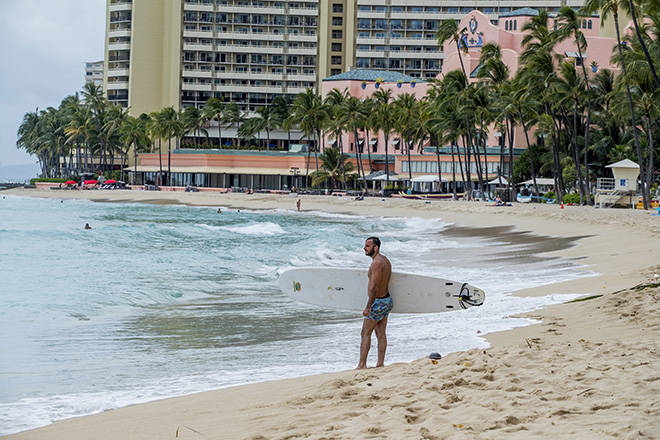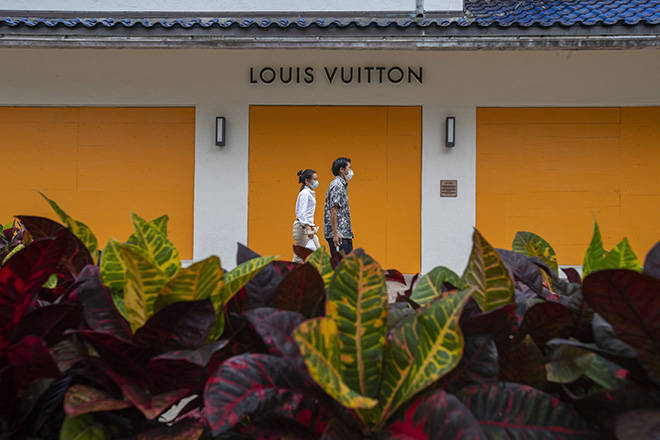Coronavirus impact drove Hawaii tourism down over 50% in March, erasing earlier 2020 gains

DENNIS ODA / MARCH 26
By the end of March, Waikiki Beach was nearly empty as coronavirus restrictions took a devastating toll on Hawaii’s tourism industry.

CINDY ELLEN RUSSELL / MARCH 31
A mask clad couple walked past a boarded Louis Vuitton on Kalakaua Avenue in Waikiki on March 31. By the end of March, Waikiki Beach was nearly empty as coronavirus restrictions took a devastating toll on Hawaii’s tourism industry.


Visitor spending and arrivals in March plummeted more than 50%, erasing earlier gains and causing double-digit losses for the first quarter as the coronavirus pandemic Opens in a new tab devastated the world’s travel industry.
Hawaii Tourism Authority reported today that March visitor arrivals were down nearly 54% compared with a year ago. Some 434,856 visitors traveled to Hawaii in March 2020 as compared with 939,064 during the same month last year.
Visitor spending fell more than 52% in March 2020, which brought in $720 million compared with more than $1.5 billion in March 2019.
A strong January and February weren’t enough to offset March’s incredible losses.
First quarter visitor arrivals fell more than 16% to just over 2.1 million from the year-ago 2.5 million. Spending, during the first three months of the year, fell more than 14% to nearly $3.9 billion, down from $4.5 billion in the first three months of 2019.
Air and cruise ship declines had already began to take their toll before mid-March when public safety policy to fight the spread of COVID-19 began to collapse Hawaii tourism.
Don't miss out on what's happening!
Stay in touch with breaking news, as it happens, conveniently in your email inbox. It's FREE!
Flight reductions started in February with restrictions on flights from China, but by March diminished travel demand and growing public safety restrictions caused severe air service drop across the markets.
Trans-Pacific air seats serving the Hawaiian islands in March fell to 943,095. The nearly 21% drop hit Hawaii’s visitor hard as the vast majority of visitors coming into the state come by air. Visitor arrivals by air fell nearly 54% to 430,691.
Starting March 13, most cruise lines voluntarily suspended their U.S. operations. Cruise ship arrivals to Hawaii in March fell nearly 65% to 4,165.
The losses rose even more in mid-March. Gov. David Ige asked upcoming visitors on March 13 to postpone their trips for at least 30 days.
Tourism was further hurt when the counties issued stay-at-home orders. Then, Ige issued a mandatory 14-day self-quarantine order for all passengers arriving from out-of-state, which began March 26. Since then, only about 4,200 visitors have come to Hawaii by air.
March arrivals and spending were down significantly across all the major islands, but Oahu was the hardest hit due to it’s higher proportion of international visitors, which tend to be more sensitive to health scares and geopolitical issues. The largest air seat losses came from Asian counties outside of Japan, which fell nearly 65%. Canada dropped nearly 49%, Oceania fell more than 37%, Japan dropped more than 27%, and seats from the U.S. West and U.S. East declined about 14%.
First quarter arrivals decreased across the islands. First quarter spending fell on every island but Molokai. Through the first quarter, statewide air seat capacity fell nearly 3% to almost 3.3 million seats. During the same period, 20 out-of-state cruise ships came to Hawaii.




